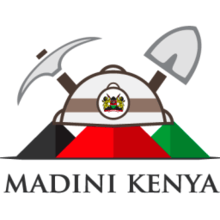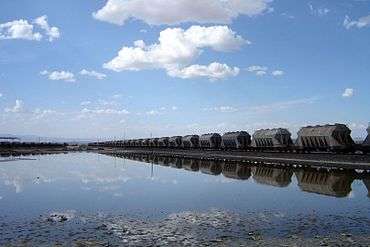Ministry of Mining (Kenya)
| Wizara ya Madini | |
 Logo of the Ministry of Mining | |
| Agency overview | |
|---|---|
| Formed | March 4, 2013 |
| Preceding agency |
|
| Headquarters |
Kenya Works Building, Ngong Road P.O. Box 30009, 00100 Nairobi, Kenya[1] |
| Annual budget | KES. 2 billion |
| Agency executives |
|
| Website | mining.go.ke |
The Ministry of Mining of the Republic of Kenya is a Kenyan government ministry that oversees the Mineral sector in the country.
The Ministry was established as an independent ministry after the 2013 general elections. The government realized that the mining industry had the potential to spur the countries economic growth . Previous to its establishment all mining related activities in Kenya were overseen by the Ministry of Environment and Natural Resources.
Hon. Najib Balala a jubilee government principle was appointed as the first Cabinet Secretary to run the newly formed ministry.
History
The ministry has been pursuing changes in the mining sector. In 2013, the ministry revoked 31 mining licenses for minerals ranging from base and precious metals, industrial minerals, non-precious minerals and gemstones.[2] As of 2015 the number rose to 65. The ministry claimed that the contracts were issued under unclear circumstances.[3]
Mining and minerals

Kenya has no significant mineral endowment. The mining and quarrying sector makes a negligible contribution to the economy, accounting for less than 1 percent of gross domestic product, the majority contributed by the soda ash operation at Lake Magadi in south-central Kenya. Thanks largely to rising soda ash output, Kenya's mineral production in 2005 reached more than 1 million tons. One of Kenya's largest foreign-investment projects in recent years is the planned expansion of Magadi Soda. Apart from soda ash, the chief minerals produced are limestone, gold, salt, large quantities of niobium, fluorspar, and fossil fuel.[4]
All unextracted minerals are government property, according to the Mining Act. The Department of Mines and Geology, under the Ministry of Environment and Natural Resources, controls exploration and exploitation of such minerals.[4]
Gold yielded an estimated 200 kg in 2010 and in recent time it has been reported a resource of 1.31 million ounces at 12.1 grams per tonne, totalling 1.3m ounces of gold. However it expects further drilling work to revise this up to at least 2m ounces by the end of the year and this was produced by small-scale artisan miners in the Migori Archaean Greenstone Belt and mostly in the Western part of the country.The Kenya Ministry of Mines has set up new procedures binding the Export of precious metals. The Sector looks for many more investors via the use of these procedures.In situations whereby a new local mining is in a business transaction with a buyer who wants to invest in mining, You have to contact the office director for the proper procedure and document acquisition to able to carry out the mining activity;
In the time between January and May 2013 out of all 500 mining licenses issued only 20 were found credible. revocation of the 65 licenses by 2015 the Ministry of Mining opened up 4.5 million acres of land to new explorers.[3]
Dan Kazungu, Kenya’s cabinet secretary for mining, said that the country was seeking to ratify its Mining Act to establish as “a robust legislative framework” to support its burgeoning mining industry.
Nonetheless Gold yielded within the EAC can circulate with the communities without restriction and little duties are paid which require a Certificate of Free Circulation of Goods, For Exportation of Gold out of Kenya to it outside world, it is an obligation that a 7% Taxes and duty be paid to the custom control Bureau together with the KRA duties to allow the gold to be ship out to it destination; For other EAC Taxes contact their Ministry of minerals or office In charge but no Gold will circulate without an EAC permit from the Government that the Gold is free and clear and of non-criminal and non-terrorist origin, unencumbered and free of any adverse claims, liens and encumbrances, and is transferable and exportable.
The Kenya Ministry of mines has levid a 5 % duty Tax on nickel, vanadium, cassiterite, colombo-tantalite, uranium, rare earth oxides, peat, cobalt, copper, platinum, hydropower, niobium, tantalum, gold, tin, tungsten, kaolin and limestone and this levid also apply for export of Diamonds, base metals, gemstones (including the unique Tanzanite) and a variety of industrial minerals (such as phosphates, mica, gypsum, limestone, graphite, quartz and vermiculite)
Together with the EAC certificate , The following documents must be apply for ; Customs Declaration Form(s), Export Permit, Proof of export duty paid, Statement of gross weight of the Shipment as determined, before delivery to the Delivery Point, by Seller, Certificate that the Gold does not contain any mercury and/or cyanide.
Investment in Mining: The EAC countries are richly endowed with a variety of mineral resources.
Burundi is well endowed with deposits of nickel, vanadium, cassiterite, colombo-tantalite, gold, uranium, rare earth oxides, peat, cobalt, copper, platinum, hydropower, niobium, tantalum, gold, tin, tungsten, kaolin and limestone.
Kenya has four belts of minerals - the gold green stone belt in western Kenya, which extends to Tanzania; the Mozambique belt passing through central Kenya, the source of Kenya’s unique gemstones; the Rift belt, which has a variety of resources including soda ash, fluorspar and diatomite; and, the coastal belt, which has titanium.
Rwanda has deposits of cassiterite, a tin ore, which is a very important ingredient of electronics components. The mineral is also found in Walikale, in DRC’s Northern Kivu Province, a part that borders Rwanda in the east. Other potentially profitable minerals include wolframite, columbite-tentalite, amblygonite and tantalite (colttan). Gold has also been explored in some parts of the country. Some semi-precious stones including tourmaline, topaz, corundum, chiastolite, amethyst, opal and agate have been discovered.
Tanzania has a wide variety of minerals including diamonds, gold, base metals, gemstones (including the unique Tanzanite) and a variety of industrial minerals (such as phosphates, mica, gypsum, limestone, graphite, quartz and vermiculite) that have a wide range of applications in ceramics, pottery, brick and tile-making, and glass manufacture as well as nickel, cobalt, copper, apatite, niobium, iron ore and coal.
Uganda also has a variety of mineral resources including copper, cobalt, tin, iron ore, tungsten, beryllium, limestone, phosphates, salt, clays, feldspar, diatomite, silica sand, glass, sand gravel, and construction materials such as granites and gneisses.
Investment opportunities exist in mining stone for the construction and building industry, phosphates for agriculture, salt for domestic and chemical uses, iron ore for the iron and steel industry, kaolin for leather tanning and pharmaceuticals, and silica sand and trona for glass manufacture; exploration and development of mineral deposits including oil, gold, copper, cobalt sulphide and hematite iron.
Whilst Kenya is a relatively new mining destination we are very pleased with the relationships we have built and the support we have received and look forward to working closely with all stakeholders as we progress this highly promising project
Mandate
The overall mandate of the ministry is to oversee the mineral sector in Kenya but more specifically to:[1]
- Oversee the exploration of minerals
- Oversee the development of the mining sector
- Oversee and set mining policies and the management of resources
- Oversee and map current resources available in Kenya
- Set general policy for the industry
- Set standards for Health and Safety in Mines
- To maintain accurate and current Geological Data
Directorates
These are the directorates of the ministry that help organise the ministry's functions. They include:[1]
- Directorate of Mineral Management and regulations
- Directorate of Geological Surveys
- Directorate of mineral promotion and value addition
- Directorate of Mine health, safety and environment
- Directorate of resource surveys and remote sensing
- Directorate of corporate affairs
- Geo-data centre and minerals certification laboratory
- Mineral audit agency
- Policy, strategy, research, legal, and capacity building agency
See also
References
- 1 2 3 4 About the Ministry of Mining | Kenya. Retrieved June 18, 2015.
- ↑ Balala revokes 31 mining licences. Retrieved June 18, 2015.
- 1 2 Balala revokes licences of 65 mining companies. Retrieved June 18, 2015.
- 1 2
.svg.png)